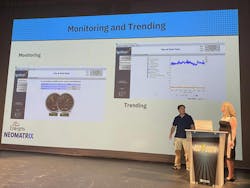It’s easy to understand why manufacturing system and device data have moved to the center of importance as IT and operations technology (OT) converge. But think back to where your operations were in 2008—the early days of industrial technology shifts that now underlie the ongoing digital transformation across industry. And remember that, in 2008, the term Internet of Things was far from ubiquitous, so the concept of connecting numerous devices and systems on the plant floor to share reams data was not yet well understood or accepted.
As you think back, consider how the technology decisions you made then still impact your manufacturing operations. Are those systems still in place? Are they still core to your current OT decisions?
A recent case study presentation on the OT decisions made by Entegris back in 2008 underscored for me how critical it is for manufacturing companies of all sizes to not just focus on resolving specific or isolated issues. Instead, it’s critical for manufacturers to think about OT from a scalable platform perspective to address specific issues on one line or at one plant while having the ability to scale beyond that line or plant to multiple lines and plants while supporting the critical connections between IT and OT for security and strategic decision-making.
The update decision
Entegris is a supplier of materials and process systems for the semiconductor, life sciences and other high-tech industries. In 2008, the company (whose annual revenues at the time were just north of $550 million) began the process of upgrading the manufacturing systems at its headquarters plant in Billerica, Mass. The focus of this first step in Entegris’s system modernization began with the HMI software on three machines—two of which were using RSView32 and one of which was using InTouch.
At that time, Inductive Automation had not yet released its well-known Ignition software (that release occurred in 2010). But the operations and IT management at Entegris were intrigued enough with Inductive Automation’s approach that they decided to move forward with Inductive Automation’s FactoryPMI and FactorySQL software.
At Inductive Automation’s Ignition Community Conference 2024, Danny Haskell, president of Neomatrix, the system integrator working with Entegris, explained Entegris’s thought process at the time the company decided to give Inductive Automation a chance. “Entegris hadn’t heard much about Inductive Automation at the time, but was amazed by the ability to purchase just one license for software that could be used to control all three machines centrally by IT.”
They were also impressed with the software’s scalability potential, as the ability to easily expand the software to multiple sites was a key reasoning behind the HMI upgrade.
The capabilities provided by FactoryPMI and FactorySQL software were so successful that Entegris upgraded to Inductive Automation’s Ignition software upon its release in 2010 to drive the scalability potential of the software platform at Entegris as well as leverage its communication and application building capabilities.
Today, two production servers in the Billerica plant run Ignition to control more than 200 machines and some 90,000 tags at “a very high level,” said Eileen Souliotis regional senior manager of automation and control at Entegris.
Underscoring the software platform’s ability to scale with the company, Souliotis said the company now also uses Inductive Automation’s Sepasoft MES (manufacturing execution system), EAM (enterprise administration module), MQTT communications, tag servers and server load sharing. She added that Entegris moved to Ignition 8.1 in 2020 to use its Perspective module to support deployment of mobile devices on the factory floor for use by operations personnel.
To better grasp how the Ignition software has been able to scale with Entegris, consider that the company currently employs abut 8,000 people at more than 40 locations worldwide and generated $3.5 billion in sales revenues in 2023—quite a jump from $550 million 2008.
With Ignition, Entegris was able to centralize its OT systems to be managed by IT and support data integration into the company’s business systems, said Souliotis. “We centralize [the data] on IT servers for best-in-class security, data integrity, backups and restoration,” she explained. “We can also share data between departments and manufacturing sites as well as share recipes between equipment and processes.”
Haskell added that Ignition also serves as industrial IoT middleware for the Entegris’s HMI/SCADA, MES, CMMS (computerized maintenance management system), quality control and analysis, ERP and CRM (customer relationship management) systems. “Ignition is their OT platform of choice to run their manufacturing plants because of its connectivity and scalability across devices and databases,” he said.
For connections to PLCs and plant floor devices, Entegris uses Ignition’s support for OPC UA. The company also uses Ignition’s support for REST, SOAP and MQTT to deliver IT and cloud connections.
A central manufacturing data platform
In their presentation, Souliotis and Haskell highlighted several key aspects of Entegris’s use of Inductive Automation’s software in its manufacturing operations:
- Using Sepasoft’s downtime analysis, Entegris was able to visualize which machines were down and when. As Souliotis pointed out, “before using Sepasoft, we knew we had an 80% runtime, but we didn’t know which machines were down and when. We knew many of our machines were down often due to loading processes, but with the downtime analysis trend charts we saw for the first time that all bays were down during lunch. Our continuous improvement manager didn’t believe this at first, but the data doesn’t lie. It showed him something he was not aware of and saved us a lot of money. We initially thought we needed to buy a new machine to increase capacity, but this analysis showed us we didn’t have to make that purchase, saving us $400,000.”
- Alarm management is key to Entegris considering that many of its plants run 24/7. With Ignition, Entegris can create custom alarm properties for its different manufacturing sites and send email or text alert notifications when issues arise. Souliotis added that Entegris is also using Ignition to manage environmental monitoring with alarms.
- Ignition’s support for Microsoft Active Directory enables Entegris to integrate it into the company’s corporate security infrastructure, giving the company the ability to deploy web-based authentication applications like federated identity, MFA (multi-factor authentication) and single sign-on. Souliotis noted that Ignition also allows users to prevent someone from running a machine remotely so that it can only be adjusted locally.
- Ignition recipe management is used by Entegris to enable users to scan a catalog number and have the associated recipe automatically loaded onto the appropriate equipment to prevent errors.
Souliotis also pointed out key training attributes with Ignition. “Basic training is free at Inductive University, which provides a roadmap for people to get up to speed on the platform. I recommend companies space out the training to make it more effective. Complete one level at a time to make the next level more understandable. Really learn the system before moving on to the next step.”
Looking at the company’s production operations across the board, Souliotis noted that Entegris has a lot of complicated processes. That’s why it was important for the company to be able to visually highlight what’s happening from a process perspective, she said. “Our goals were to connect people, equipment and business systems in real time; increase our visibility of manufacturing operations at all levels; provide real time correction of operations when needed; increase utilization, efficiency and quality of our manufacturing operations; and push statistical data to an SPC enterprise level system. We’re able to do all of that with Ignition.”
Leaders relevant to this article:




